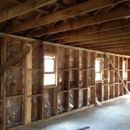Suggestions for insulating a large garage workshop
Hi everyone. I just purchased a property in western Massachusetts zone five a. I am planning to renovate the existing 24 x 60 barn for use as a year-round workshop. The building is slab on grade with 2 x 6 framed walls 24 inches on center, sided with rough pine board and batten nailed to the studs and bracing. Currently, there is a bit of air exchange between the interior and exterior due to some of the battens pulling away from the nailers. Additionally, when the building was built the builder installed a four mill plastic barrier between the studs and the board and batten which is now badly deteriorated.
The ceiling joists and rafters are also 2 x 6, 24 on center and have a clearance of 8 feet under the joist.
I have already had 100 amp electrical service installed and plan to also add propane for heat. The space will be used frequently, 3 to 7 times per week however I do not plan to keep the building conditioned at all times.
My questions are as follows:
What is the best way to seal and insulate the walls from the inside of the building?
What are my options for insulating the roof as a cathedral ceiling given the existing framing?
GBA Detail Library
A collection of one thousand construction details organized by climate and house part










Replies
AJ- thanks for the quick reply.
Are you suggesting for the walls I should install the thermax cut and cobble in between studs, taping to the studs or sheath interior surface and blow in cellulose behind?
What is the recommended procedure for installing Sheetrock over the thermax? Or in this application is it even necessary?
Benjamin,
My advice is similar to AJ's.
Removing the polyethylene from the walls is a good idea. Installing some cut-and-cobble polyiso between the studs is also a good idea, but it doesn't have to be Thermax.
Insulating the stud bays with cellulose after installing the polyiso is a good idea.
If you want an insulated cathedral ceiling (to keep your attic warm), there are lots of options. Here is a link to an article that discusses all the options: How to Build an Insulated Cathedral Ceiling.
You didn't mention whether or not you plan to insulate the slab. The slab will be the coldest surface in the room. It's possible to insulate the slab with 2 inches of rigid foam above the slab followed by a layer of 3/4-inch tongue-and-groove plywood, but that work is expensive.
Remove plastic
add interior thermax rigid foam with taped seams (NOT CUT AND COBBLE) added foam to interior surface of stud wall. Tape seams, caulk perimeter of stud wall.
densepack studs with cellulose using exterior siding and interior rigid foam with access holes cut to blow in
ceiling
thermax interior taped seams
loose fill cellulose
vent attic
PGH Zen master aj is not a "cut and cobbler."
Rigid foam goes on interior surface of walls and ceiling. (since in your case we are keeping the exterior "value" as is.
I am a huge fan of interior rigid foam. Martin and i do not agree on this point. Most of what Martin posts is good, I will have continue to work with my grasshopper-Martin on this point of contention.
One more point. In my area an insulation contractor could knock out the project quickly and efficiently and his cost would be barely higher than big box material costs as my insulation contractors buy at good prices better than I can buy so they cover labor for some of the best prices of any part of building a home.
The only advantage of doing it yourself is that you could do it in stages to pay for the work as you get work done.
Hello Benjamin. Upon researching the challenge that I have I've discovered your article. I see you posted some months ago. I'm curious as to what process you moved forward with and if you'd like to share any info you found valuable. Thanks in advance.